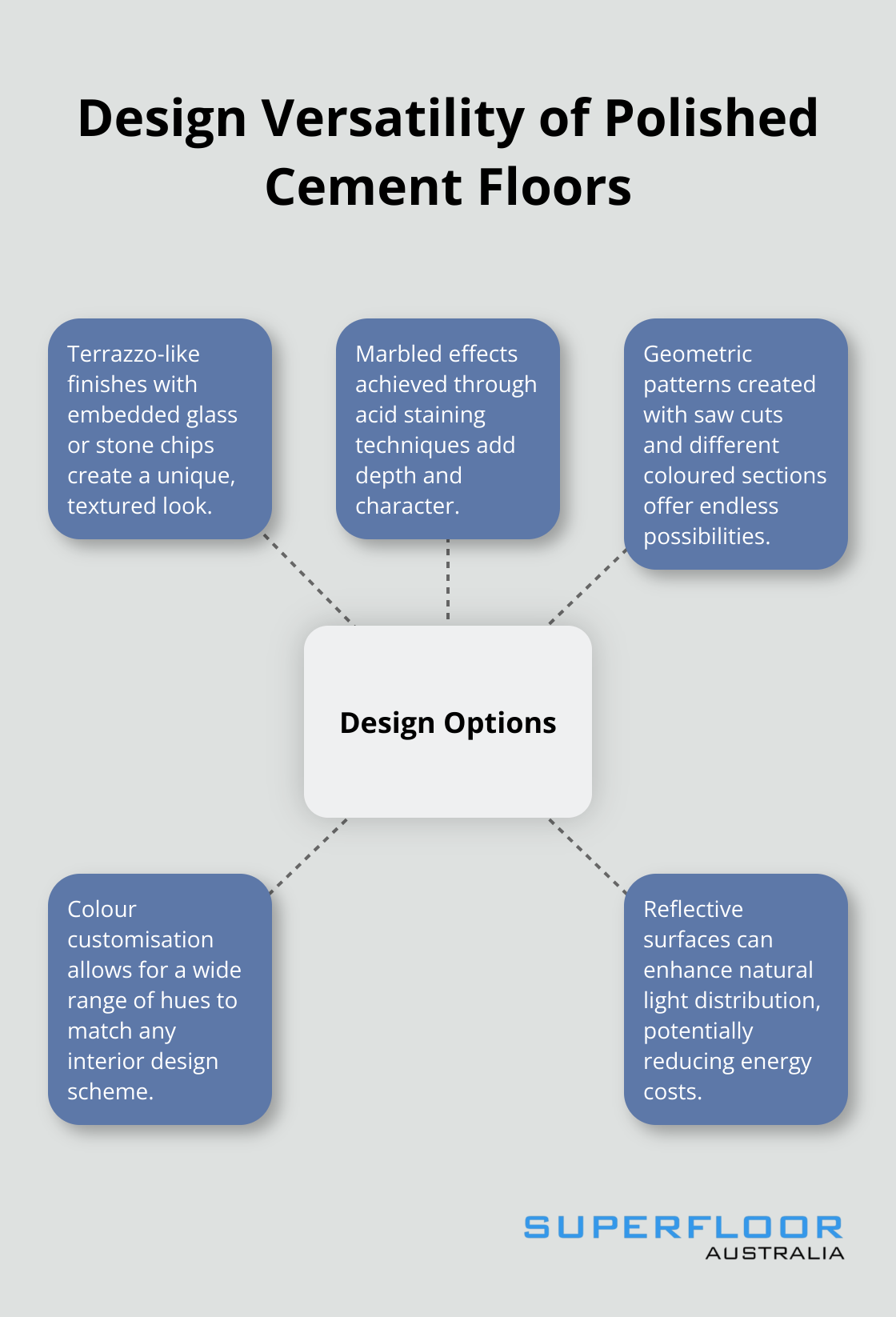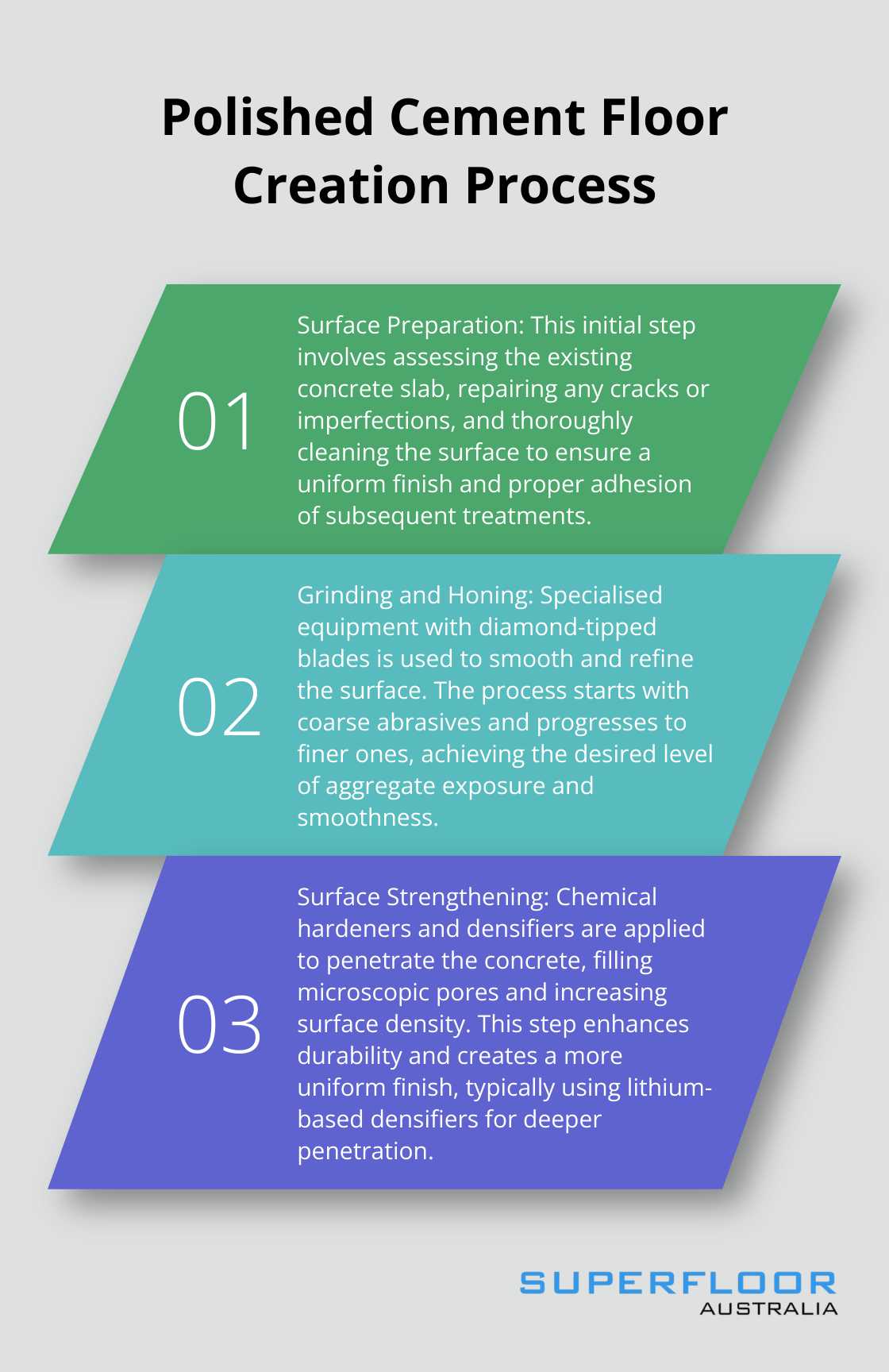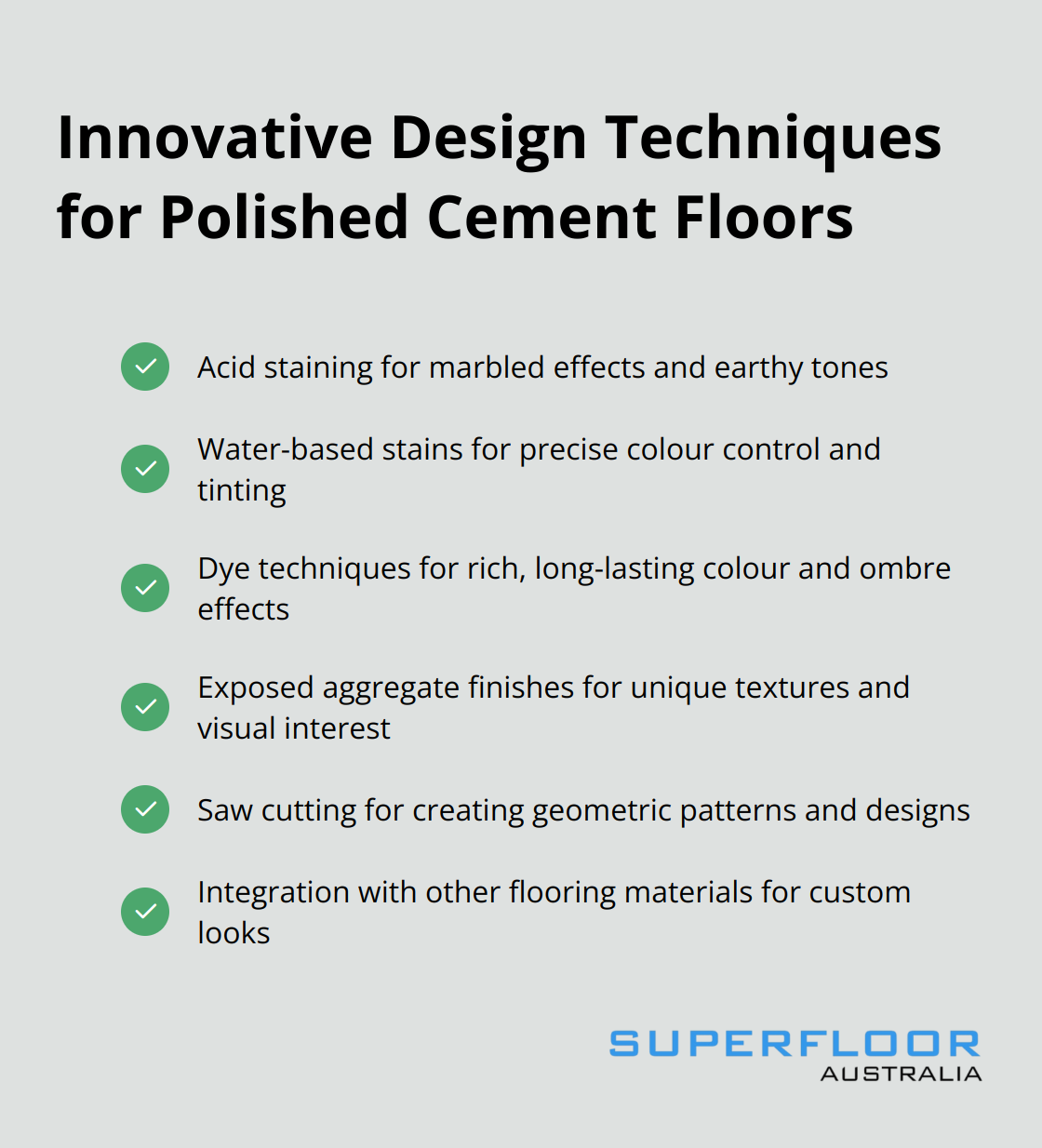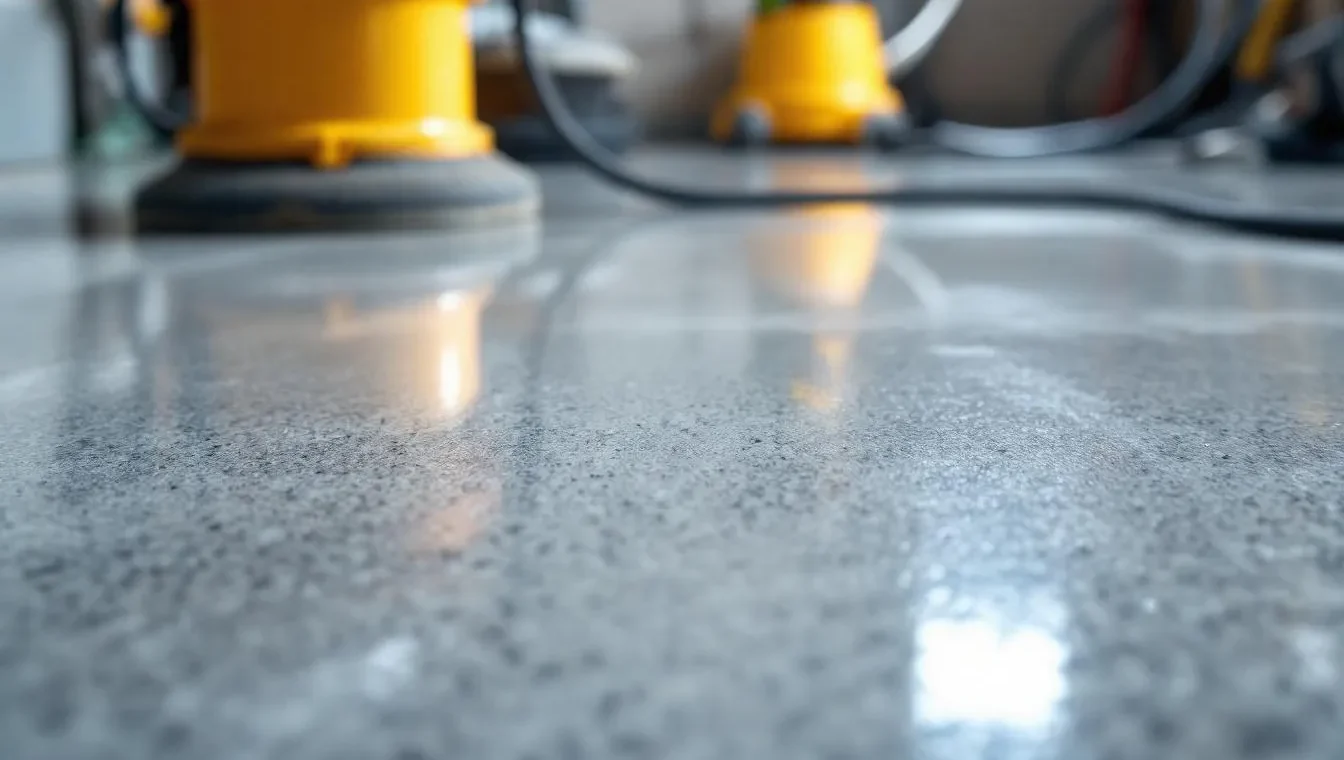Polished cement floors are transforming interior spaces with their sleek, modern aesthetic. At Superfloor Australia, we’ve seen a surge in demand for this versatile flooring option.
These floors offer unparalleled durability and low maintenance, making them ideal for both residential and commercial settings. Our blog post will guide you through the process of creating stunning polished cement floors and explore exciting design possibilities.
Why Polished Cement Floors Are Trending
A Distinctive Aesthetic
Polished cement floors have captured the design world’s attention with their unique blend of style and functionality. These floors boast a smooth, reflective surface that creates a modern, industrial look, increasingly sought after in both residential and commercial spaces. The trend towards polished concrete and decorative concrete floor finishes is a natural one, with more and more homeowners moving away from traditional tile options.
Unmatched Durability
The exceptional durability of polished cement floors sets them apart from traditional flooring options. These robust surfaces can withstand heavy foot traffic, impacts, and even chemical spills without showing signs of wear. This impressive longevity makes them an excellent choice for high-traffic areas such as retail stores, warehouses, and busy households.
Effortless Maintenance
Polished cement floors simplify cleaning routines. Unlike carpet or hardwood, these surfaces don’t require special cleaning products or time-consuming maintenance procedures. A quick sweep and occasional damp mop typically suffice to keep them looking pristine. This low-maintenance aspect particularly appeals to commercial spaces where cleaning costs can accumulate rapidly.
Design Versatility
The design possibilities of polished cement floors are virtually limitless. These surfaces can be customised with various colours, patterns, and finishes to complement any aesthetic. We’ve observed a growing trend in adding decorative aggregates or using staining techniques to create unique looks. Popular options include:
- Terrazzo-like finishes with embedded glass or stone chips
- Marbled effects achieved through acid staining
- Geometric patterns created with saw cuts and different coloured sections
This versatility allows for truly personalised floors that can enhance any interior style, from minimalist modern to rustic industrial.

Eco-Friendly Option
Polished cement floors also offer environmental benefits. They often utilise existing concrete slabs, reducing the need for additional materials. The polishing process typically doesn’t involve harsh chemicals or VOCs (volatile organic compounds), making it a more eco-friendly choice compared to some other flooring options. Additionally, the reflective properties of polished concrete can help improve natural light distribution, potentially reducing energy costs for lighting.
As we explore the process of creating these stunning floors in the next section, you’ll discover how the combination of skilled craftsmanship and advanced technology transforms ordinary concrete into extraordinary surfaces.
How Does the Polished Cement Floor Process Work?
Preparing the Surface
The creation of stunning polished cement floors starts with meticulous surface preparation. Our team assesses the existing concrete slab, identifies and repairs any cracks or imperfections. We then use high-pressure washers to clean the surface, which removes dirt, grease, and old coatings. This initial step (often overlooked by less experienced contractors) ensures a uniform finish and proper adhesion of subsequent treatments.
Grinding and Honing
The next phase involves grinding, where we employ specialised equipment fitted with diamond-tipped blades. We typically start with coarse diamond abrasives and move to finer ones. This process smooths out the surface and exposes the desired level of aggregate. The choice of grit sequence depends on the desired finish – whether it’s a salt-and-pepper look or full aggregate exposure.
During honing, we refine the surface further. This stage uses finer grits to achieve the desired level of smoothness and sheen. The number of passes and grit levels used significantly impact the final appearance of the floor.
Surface Strengthening
After grinding and honing, we apply chemical hardeners and densifiers. These products penetrate the concrete, fill in microscopic pores, and increase the surface density. This step enhances durability and creates a more uniform finish. We typically use lithium-based densifiers for their deeper penetration and ability to create a harder surface compared to sodium or potassium alternatives.
Final Polishing and Sealing
The last stage involves final polishing and sealing. We use progressively finer resin-bonded diamond pads to achieve the desired level of gloss. This can range from a matte finish to a high-gloss mirror-like surface. The process usually starts at 400 grit and can go up to 3000 grit for maximum shine.
Finally, we apply a high-quality sealer to protect the polished surface from stains and wear. There are two common types of sealers – film-forming and penetrating, each with their own benefits and suitable applications.

With the polishing process complete, it’s time to explore the exciting design possibilities that polished cement floors offer. From vibrant colours to intricate patterns, the next section will showcase how these versatile surfaces can transform any space.
Transforming Spaces with Polished Cement Floor Designs
Polished cement floors offer a canvas for creativity, allowing homeowners and designers to craft unique spaces that reflect personal style and architectural vision. We at Superfloor Australia have witnessed a wide range of design possibilities that extend far beyond the standard grey concrete look.
Vibrant Colours and Staining Techniques
Colour options for polished cement floors have expanded dramatically in recent years. Acid staining remains a popular choice, creating marbled effects with earthy tones like coffee brown, which provides a leather-like or marbled accent to concrete surfaces. For more colour options, water-based stains can be applied full strength for tinting polished concrete.
Dye techniques allow for even more precise colour control. These penetrate deeply into the concrete, resulting in rich, long-lasting colour. Dyes can create ombre effects, transitioning from light to dark across a room, which adds depth and visual interest.
Incorporating Aggregates and Decorative Elements
Exposed aggregate finishes are gaining popularity, especially in commercial spaces. Both polished concrete and exposed aggregate are durable and stylish options for concrete flooring, serving different purposes based on specific needs.
A recent restaurant project incorporated crushed mirror pieces into the floor, creating a dazzling effect under the venue’s lighting. For a more subtle approach, locally sourced stone aggregates can tie the flooring into the surrounding landscape in residential projects.
Creating Patterns with Saw Cuts
Saw cutting allows for the creation of geometric patterns directly in the concrete. This technique can transform a simple floor into a work of art. Saw cuts can create everything from simple grid patterns to complex mandala designs.
A boutique hotel lobby recently implemented a herringbone pattern using saw cuts and contrasting stain colours. The result was a high-end look that rivalled expensive tile work but with the durability and ease of maintenance of polished concrete.
Seamless Integration with Other Materials
Polished cement floors don’t have to stand alone. They can integrate beautifully with other flooring materials for a truly custom look. Polished concrete can combine successfully with hardwood, creating striking transitions between living areas.
A recent high-end residential project inlaid brass strips between sections of polished concrete and marble, creating a luxurious, Art Deco-inspired floor. The key to successful integration is careful planning and precise execution to ensure smooth transitions and proper levelling.

The design possibilities for polished cement floors are virtually limitless (from bold colours to intricate patterns). These versatile surfaces can adapt to suit any aesthetic preference or functional requirement. As innovative techniques and materials continue to emerge, the potential for creating truly unique and stunning polished cement floors only grows.
Final Thoughts
Polished cement floors have transformed interior design by combining aesthetics with functionality. These surfaces offer unmatched durability and low maintenance requirements, making them attractive for residential and commercial spaces. The versatility of polished cement floors allows for endless design possibilities, from vibrant colours to intricate patterns, and seamless integration with other materials.
Professional installation ensures the best results for polished cement floors. At Superfloor Australia, we have the expertise to deliver high-quality polished concrete flooring that enhances both aesthetics and durability. Our team’s precision and craftsmanship tailor lasting results to individual needs.
Polished cement floors represent a smart investment for any property. These floors improve visual appeal while contributing to functionality and efficiency (potentially reducing energy costs through enhanced light distribution). With proper care, polished cement floors will continue to impress and perform for years, making them a worthwhile addition to any space.
